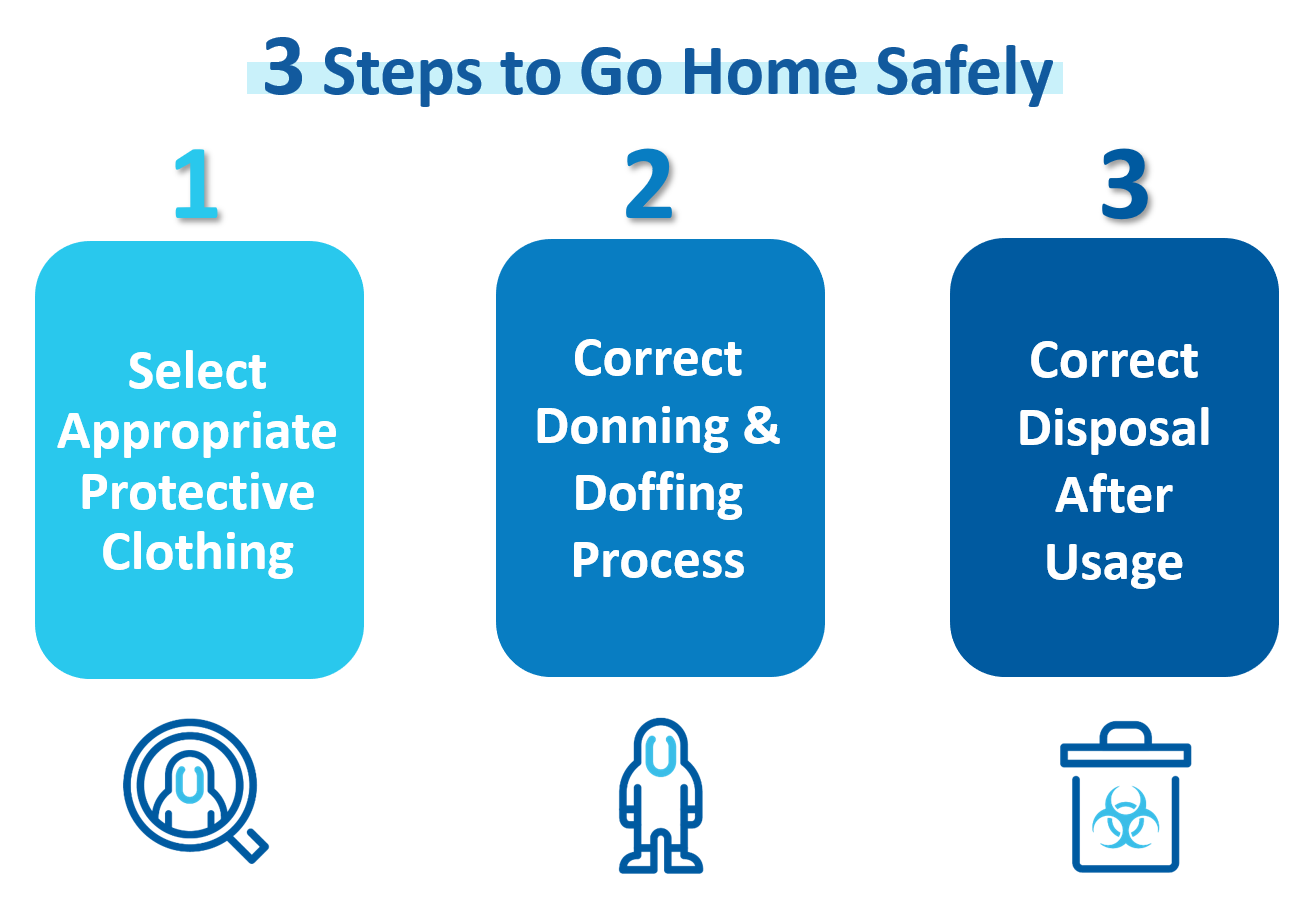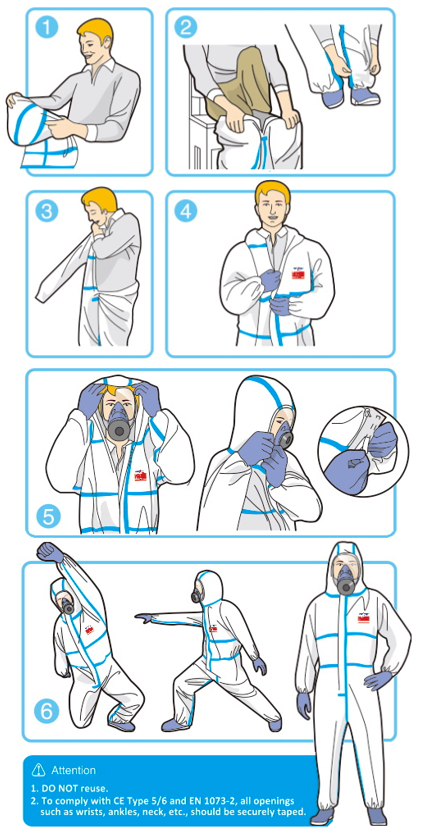Some frontline people thought that as long as they wear personal protective equipment (PPE) at the workplace, they will be safe and fully protected. Is that correct? In January 2021, a doctor at Taoyuan General Hospital in Taiwan still became infected while treating COVID-19 patients while wearing full PPE. So, why was the doctor still got infected under full PPE covered?
Every worker wants to return home safe and sound after the task. A while ago, we have been educating The Golden Triangle Rules to Go Home Safely from Work. Whereas, in this article, we will focus on the crucial 3 Steps to Go Home Safely as (Figure 1.) below that you must follow to make sure safely home and keep hazards away from your family.

Figure 1: The 3 Steps to Go Home Safely
Step 1: Select appropriate protective clothing
Instead of being based on the sector, the risk enforcement requirements are based on the hazards present. Also, not every frontline worker will face the same dangers, and many harmful agents are imperceptible and have a long-term impact. Therefore, before deciding on appropriate protective clothing, the initial step is to identify your occupational risks and perform a hazard assessment, which is generally listed below.
- Identify the hazards – discover what could be risky in the working environment.
- Conduct Risk Assessment – understand the type of harm that the danger may cause, and the probability of it occurring.
- Monitor risks – implement effective risk control measures.
- Review on a regular basis and update as needed.
Take identifying the chemical hazards for example. The safety manager shall evaluate what hazards the frontline operators will encounter on their daily tasks. The common phases of chemical hazards are shown in Figure 2. These harmful agents may contact the skin in a variety of ways, including jets, sprays, splashes, soaks, and direct contact.

Figure 2. The common phases of chemical hazards
If these hazards are inevitable and will potentially be contacted by frontline operators, then the safety manager should consider the required coverall for them to minimize hazardous risk. But how do you choose the appropriate coverall?
The protective clothing chosen should comply with Regulation (EU) 2016/425, which is the most rigorous PPE standard currently in effect. Then, select the types of coveralls according to the protection level needed as CE Standard, you can also find in What should you understand about CE test standard for protective clothing? Select an appropriate coverall in accordance with CE Standard and the equivalent protection level (Figure 3.) will help you minimize the occupational risks.

Figure 3. The protective level of protective clothing
Step 2: Correct donning and doffing process
After the selection of coverall, the next crucial step is correct donning and doffing procedures. For the removal of the coverall, it is relatively critical because frontline personnel may be contaminated if he accidentally contacts the hazards on the outside of the contaminated garment by taking it off improperly or carelessly. As a result, frontline personnel must be trained on a regular basis to ensure their safety.
The correct donning and doffing instructions are advised by ULTITEC below.
- Donning Processes
- Select appropriate coverall and read User Instruction thoroughly.
- Remove shoes and secure trousers into socks. Step into legs of coverall and place coverall over safety boots.
- Pull coverall towards arms and shoulders.
- Pull zipper halfway up. Put on a face mask (or respirator) and goggles. Pull hood over as head coverings. Cover sleeves over gloves.
- Zip up coverall to chin and ensure hood fits tightly to face, and seal storm flap with adhesive tape if any (Applicable for Type 3 and Type 4)
- Stretch to ensure coverall fits appropriately for ease of work movement and optimum protection.

Figure 4. ULTITEC Coverall Donning Instruction
- Doffing Processes
- Remove adhesive tape (Applicable for Type 3 and Type 4)
- Unzip to the waist.
- Grab outer part and pull hood away from the head. Avoid contaminated gloves to touch the head.
- Release the first arm and strip off the glove from behind the back.
- Release the first arm from coverall and glove. Release second arm and glove from inside of coverall. Sit and roll down contaminated coverall from inside towards outside.
- Draw out legs from safety boots. Use a clean hand to remove goggles and face mask (or respirator) from behind. Fold or roll into a bundle and dispose of coverall responsibly.

Figure 5. ULTITEC Coverall Doffing Instruction
Please view the full instruction here or the video ULTITEC donning and doffing instruction.
Step 3: Correct disposal after usage
It is important to properly dispose of coveralls after they have been used and removed in order to prevent people from touching the used garment. The contaminated garments must be disposed of in the same manner as contaminated waste and in accordance with national regulations. According to the World Health Organization, medical waste, such as contaminated protective clothing, should be disposed of in a closed bin after being safely removed.
Here is the correct contaminated coverall disposal instruction after usage:
- Dispose of the used coverall separately from the rest of the trash.
- Make sure the garbage bag with the hazardous label is firmly fastened
- Place the bag in a lidded hazardous mark rubbish bin
- Hand over to professional cleaning staff for follow-up disposal
 |
 |
|
Figure 6. Lidded bin and fastened bag with hazardous label |
Figure 7. The Professional cleaner takes the bin |
Conclusion
Don’t assume you are invincible only by wearing a coverall. Your occupational safety cannot be guaranteed if you do not select appropriate protective clothing, do not initiate the donning and doffing process correctly, and do not dispose of it correctly after use. Remembering these 3 critical steps and putting them into action effectively will help you return home safely with full preparation for the next working day.

